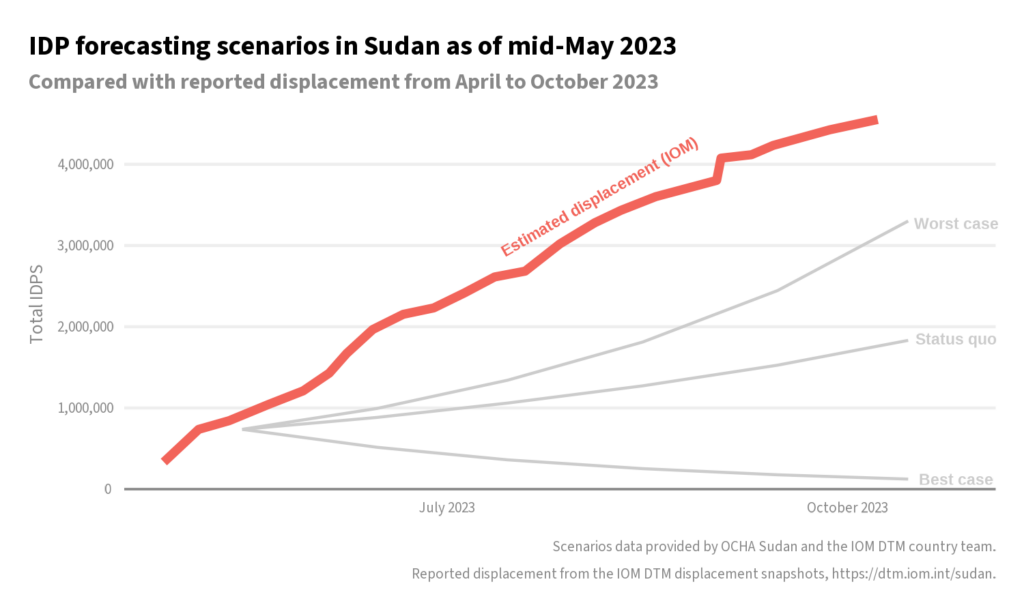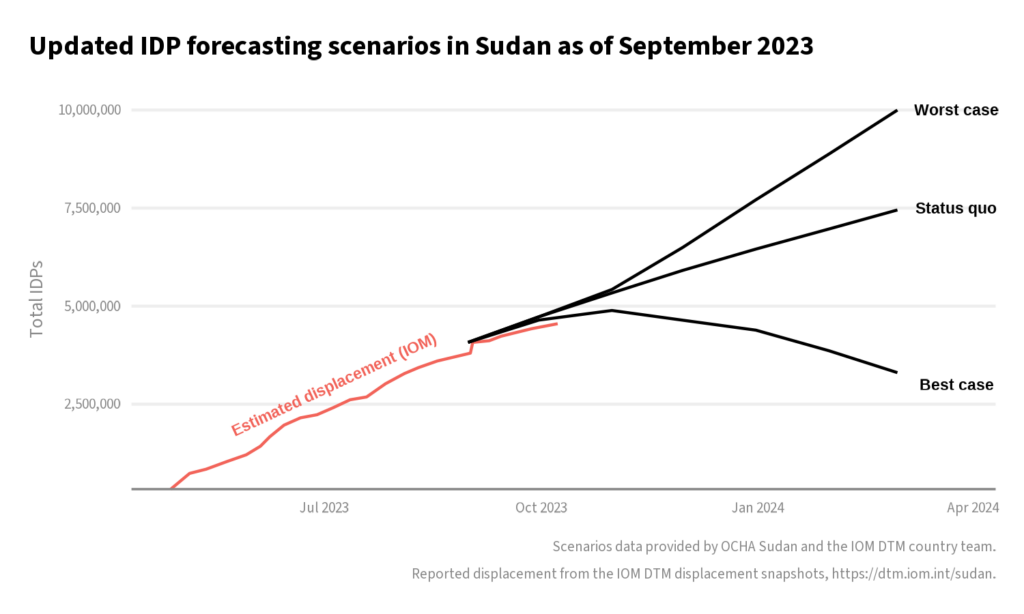Share
On 15 April 2023, conflict escalated across Sudan, with initial fighting around Khartoum expanding into other areas of the country, particularly Darfur. The new conflict forced more than 218,000 people to flee across borders and displaced over 730,000 people inside the country in the first four weeks of the conflict, according to OCHA. These new displacements were in addition to the almost 3.8 million internally displaced people (IDPs) in Sudan, primarily concentrated in Darfur, prior to the recent escalation in violence.
We worked with OCHA and IOM colleagues in Sudan to develop scenarios for internal displacement that could be included in the revised 2023 Humanitarian Response Plan. Three scenarios were developed that best represented the large uncertainties in the displacement baseline and future development of the conflict and its impacts. The worst-case scenario was for over 3 million people to be displaced by October (see chart below).
 However, the conflict and crisis escalated much faster and with a wider geographical spread than was anticipated. By the beginning of August 2023, estimated displacement in the country already surpassed the forecast in the worst-case scenario, and the numbers continued to rise.
However, the conflict and crisis escalated much faster and with a wider geographical spread than was anticipated. By the beginning of August 2023, estimated displacement in the country already surpassed the forecast in the worst-case scenario, and the numbers continued to rise.
As of November 2023, IOM estimates that 4.9 million people have been displaced internally since the new conflict began in April (see chart below). With nearly 1.2 million people leaving Sudan for neighboring countries, particularly Chad, Egypt, and South Sudan, total displacement due to the current crisis is estimated above 6 million people.
 These forecasting scenarios have been updated for the 2024 Humanitarian Needs Overview, due to be published in December 2023, as part of the risk analysis and needs forecasting section of this document. Given the rapid escalation in displacement over the past six months, OCHA and IOM have updated the scenarios to reflect the continued uncertainty in how the crisis will develop.
These forecasting scenarios have been updated for the 2024 Humanitarian Needs Overview, due to be published in December 2023, as part of the risk analysis and needs forecasting section of this document. Given the rapid escalation in displacement over the past six months, OCHA and IOM have updated the scenarios to reflect the continued uncertainty in how the crisis will develop.
The numbers now range from a worst-case scenario of 10 million displaced people by April 2024 to a best-case scenario of around 3 million displaced people, all related to the conflict that started in April 2023 (see chart below).
The three scenarios are:
- Worst case: conflict intensifies across the country, with continued displacement from Khartoum and new conflict in previously unaffected urban centers driving significant growth in levels of displacement.
- Status quo: while the current conflict does not spread to new areas of the country, current hotspots continue to see fighting, with only temporary ceasefires and pauses in conflict allowing humanitarian access and operations to resume, but displacement continues to grow at the current pace.
- Best case: successful international mediation reduces hostilities across the country, as humanitarian access, reconstruction, and initial return operations start to show reductions in displacement.
 Sudan is now the world’s largest internal displacement crisis. Even if the number of people displaced begins to slow or even reduce, the humanitarian emergency will be far from over. Nearly 25 million people were in need of assistance in Sudan in 2023, and as of November 2023, only 34 percent of the response plan has been funded.
Sudan is now the world’s largest internal displacement crisis. Even if the number of people displaced begins to slow or even reduce, the humanitarian emergency will be far from over. Nearly 25 million people were in need of assistance in Sudan in 2023, and as of November 2023, only 34 percent of the response plan has been funded.
Find the data used in these charts on IOM’s Sudan displacement dataset on HDX. Send questions or comments to centrehumdata@un.org.